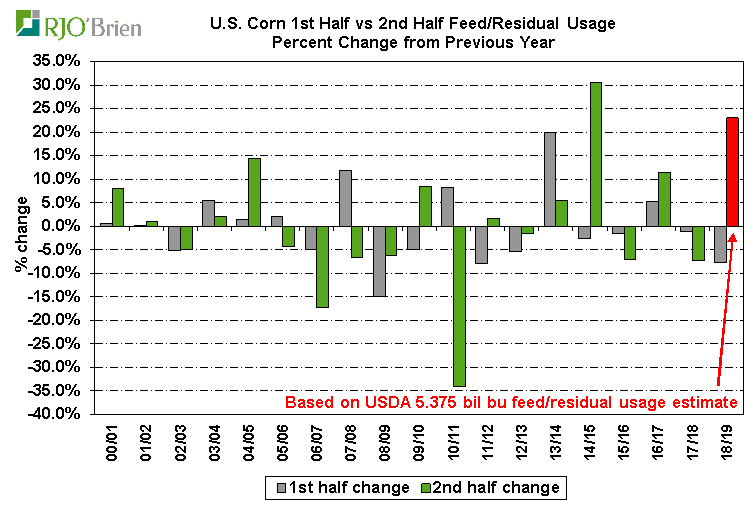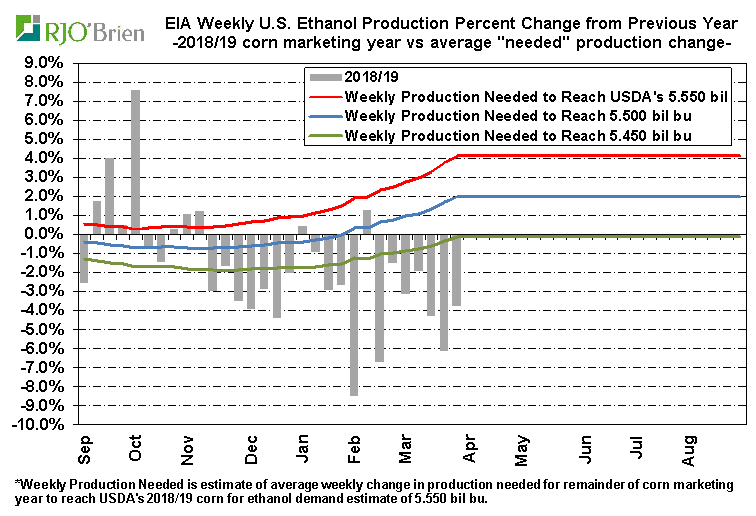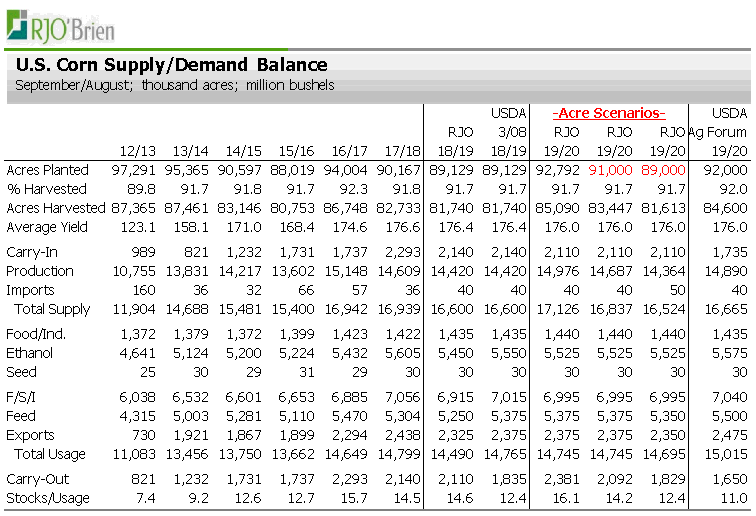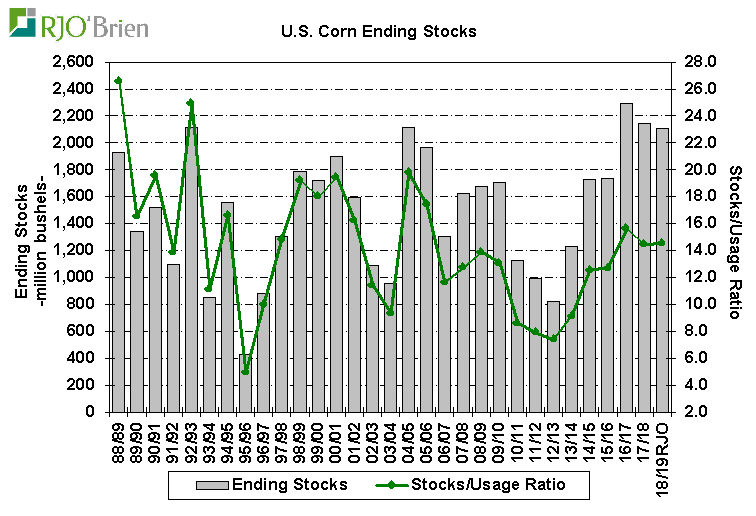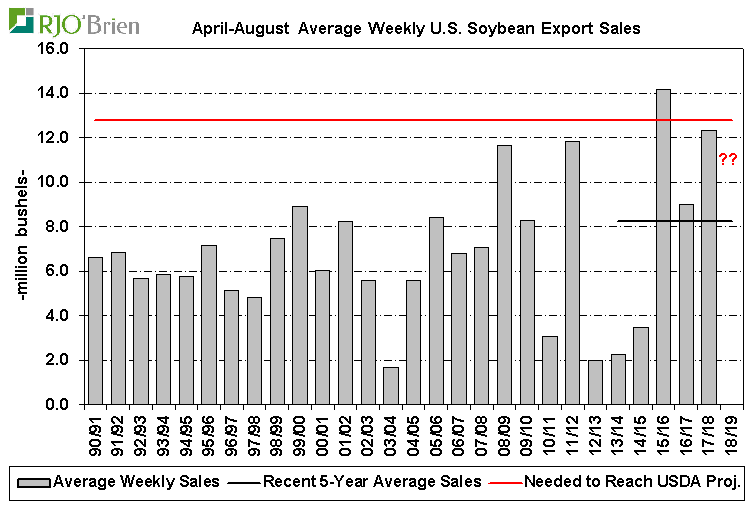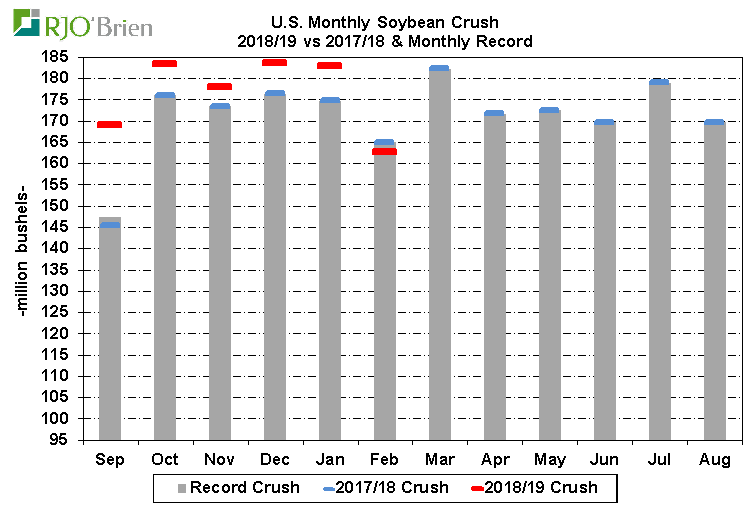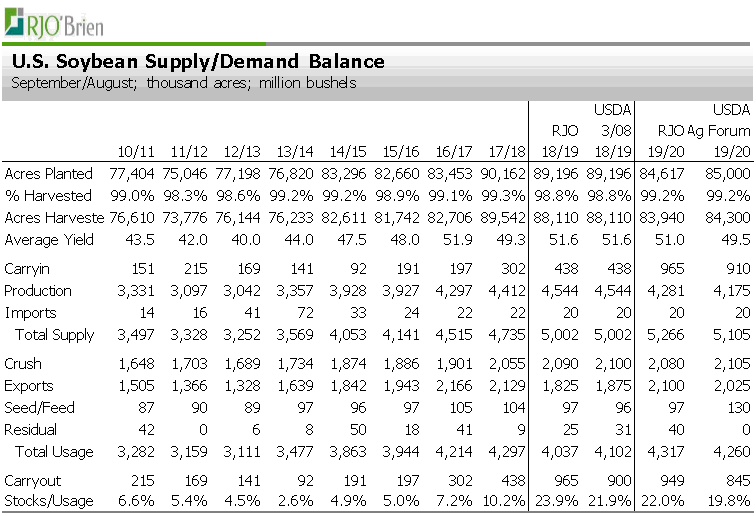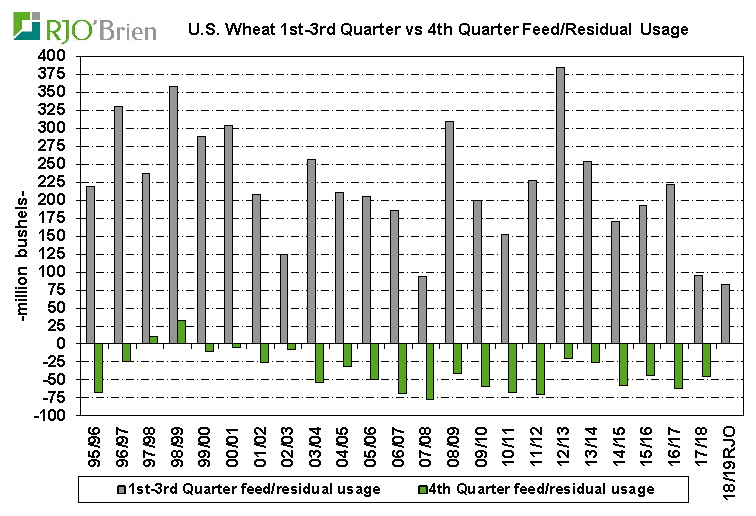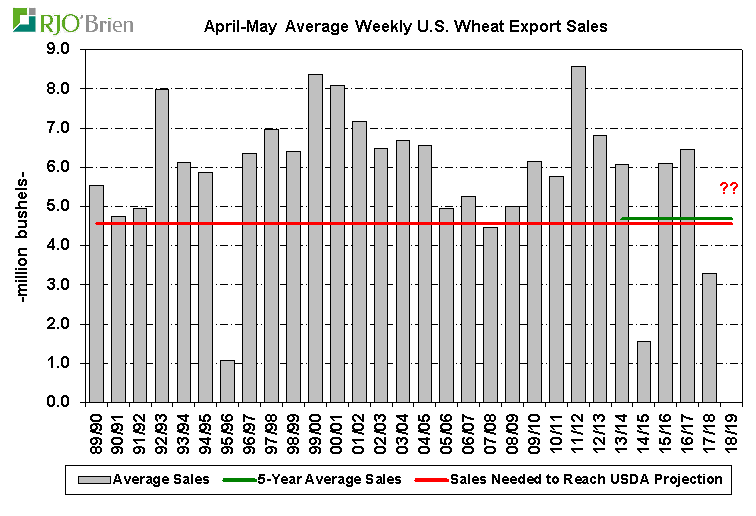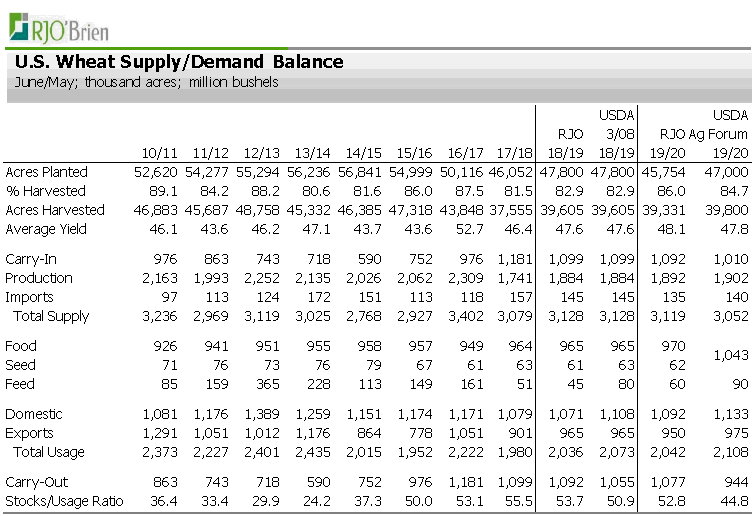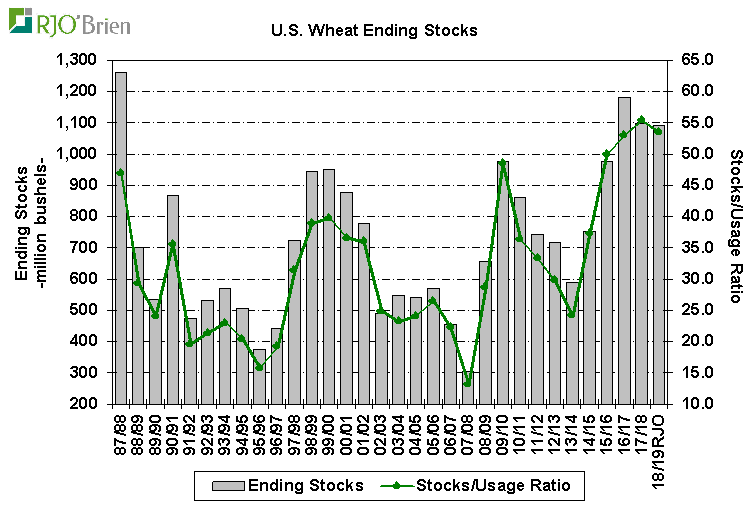USDA will release the monthly WASDE supply/demand balance sheet report, providing updates of U.S. demand ideas, as well as global balance sheet revisions. This month’s report will provide the first look at the USDA’s view of implications related to the March 29 quarterly Grain Stocks report on the 2018/19 balance sheets. USDA does not provide their initial official estimates of 2019/20 until the May report.
At the time of this post, wire services had yet to publish the average trade estimate information. A summary of the average trade estimates will be posted when it is available.
Corn
Substantial demand concerns are in place on multiple fronts, with feed/residual usage and corn for ethanol usage clearly being in need of downward revisions, while risks remain for 2018/19 exports to fall short of the USDA’s current projection, as well.
The March 29 quarterly Grain Stocks report signaled a very likely downward revision in the USDA’s 2018/19 feed/residual usage estimate is forthcoming. While March 1 stocks at 8.605 billion bushels were sharply higher than expected, implying 2nd quarter feed/residual usage at an unexpectedly-low 1.181 billion bushels, down more than 21% from last year’s 1.503 billion, calling into question the validity of the stocks figure or the potential of last year’s crop being understated, we feel USDA has little choice but to lower their annual feed/residual usage estimate in reaction. Based on implied 2nd quarter feed/residual usage at that level, total 1st half feed/residual usage of 3.472 billion bushels was down more than 7% from last year’s 3.758 billion and would require total 2nd half feed/residual of 1.903 billion bushels in order for the USDA’s current annual estimate to be accurate – a massive 23% above last year’s 1.546 billion bushels. Given the potential statistical anomaly reflected in the 2nd quarter number, there could be some risk of an “adjustment†being seen in future Grain Stocks reports, but for now, we feel USDA must at least partially reflect the lower demand in their balance sheet.
The following chart shows the USDA’s April WASDE report feed/residual usage revision from March as it related to the March 1 corn stocks report deviation from the average trade estimate. In each of the last six instances when March 1 corn stocks were above the average trade estimate, regardless of degree of deviation, USDA subsequently lowered their annual feed/residual usage estimate in the April WASDE report. In each of the last four years, USDA lowered feed/residual usage by 50 million bushels in April, with March 1 corn stocks being above expectations by anywhere from 7-182 million bushels, while USDA lowered feed usage by 150 million bushels in April 2013 following March 1 corn stocks being 369 million bushels above expectations. Last Friday’s report reflected March 1 stocks 270 million bushels above the average trade estimate and would appear to justify a reduction in the USDA’s feed usage estimate of around 100 million bushels based on their historical tendencies. We have lowered our 2018/19 feed/residual usage estimate to 5.250 billion bushels, 125 million below the USDA.
As we have discussed ad nausea for weeks/months, the USDA’s 5.550 billion bushel corn for ethanol usage estimate appears considerably too high, with the EIA’s weekly ethanol data reports supporting that view week in and week out. Another downward revision is as close to a guarantee when it comes to potential USDA revisions, but we’re hopeful they are more aggressive this time around rather than simply another 25 million bushel stairstep-type reduction. As we cover this situation regularly in our weekly write-ups of the EIA’s ethanol data on Market Insights, we don’t need to beat a dead horse, but just to recap, U.S. ethanol production has averaged 3.9% below year ago levels over the last 7 weeks and 3.1% below last year over the last 20 weeks. For the first 7 months of the 2018/19 marketing year, actual corn used for ethanol production is down 155 million bushels from last year vs the USDA’s 5.550 billion bushel annual estimate reflecting ideas of a 55 million bushel decline for the entire year. To reach the USDA’s current estimate, April-August ethanol production would need to run more than 4% above year ago levels. Annual usage 100 million bushels less than the USDA’s current estimate would still need ethanol production to run unchanged from last year, while a 150 million bushels less would require production to run only 2.2% below last year. Accordingly, a 100 million bushel cut in the USDA’s estimate appears fully justified at this time, while we hope they’re a bit more realistic and cut their estimate by at least 50 million bushels this time around.
Unfortunately, the demand concerns don’t stop with only feed/residual usage and corn for ethanol usage as notable questions remain about 2018/19 U.S. corn exports, as well. While the prospect for U.S. corn to be included in whatever “goodwill†purchases are made by China once a trade deal is struck, each week pushes the calendar that much later for old crop supplies to be involved, while the expected very large South American crop this year adds a notably limiting factor to overall sales prospects over the last five months of 2018/19. As it stands today, based on the level of sales currently on the books, U.S. corn export sales would need to average roughly 26.5 million bushels/week during April-August in order to reach the USDA’s 2.375 billion bushel export estimate, which would be the 2nd highest sales for the period of the last 8 years. As seen in the following chart, only last year and 2015/16 saw average weekly sales anywhere above 20 million bushels from this point forward and both were years of South American crop problems. Without that being the case, corn sales never topped 18 million bushels/week from this point forward and averaged only 13 million bushels/week in non-problematic South American crop years since 2010/11. A large Chinese purchase certainly could/would change this view, but for now, given the impact already being seen on U.S. sales activity as a result of the sizable Argentine crop and expected Brazilian safrinha crop, we feel USDA is justified to tick their export estimate lower this month, as well. However, we feel this likely is the lowest probability revision for USDA at this time as they may hold onto optimism for Chinese sales. We’re currently estimating 2018/19 U.S. corn exports 50 million bushels below the USDA.
While we clearly do not expect USDA to lower total demand ideas anywhere near our current expectations in a single month, we feel 2018/19 corn demand could very well prove 200-300 million bushels less than the USDA’s March WASDE report ideas reflected, eventually pushing ending stocks above 2.0 billion bushels from their current 1.835 billion bushel projection. However, we will be surprised if USDA does not lower total demand by at least 100 million bushels in next week’s report. We’re currently estimating U.S. old crop corn ending stocks at 2.110 billion bushels.
Soybeans
While we also feel there is some risk of lower total 2018/19 U.S. soybean demand than USDA is currently reflecting in their balance sheet, this appears far less certain than the situation in corn. The export outlook remains considerably muddied by the Chinese trade situation, although we have become a bit less optimistic on prospects for reaching the USDA’s export program of late despite and/or in light of their most-recent purchase of U.S. soybeans. Additionally, the potential for a modest slowdown in crush activity we’ve discussed in the past appears to be coming to fruition increasing the possibility 2018/19 crush may not quite reach the USDA’s current projection as well.
Starting with the export situation, without notable additional old crop U.S. soybean purchases by China, we feel 2018/19 exports will very likely fall short of the USDA’s 1.875 billion bushel projection. Taking into account the recently-announced Chinese soybean purchases of around 1.6 MMT, we estimate April-August U.S. soybean sales would need to average roughly 12.8 million bushels/week, which would actually be the 2nd highest sales for the period on record – falling only below 2015/16’s 14.2 million bushel/week average and would be above last year’s 12.3 million bushel/week average from this point forward. Given the huge Argentine crop just starting to be harvested and Brazil’s very aggressive early export pace of this year’s crop, even though exports are expected to slow considerably September forward, realizing the 2nd highest on record sales pace, as needed, appears to be a rather lofty goal without the occurrence of atypical sales to China hitting the books for 2018/19 shipment. On that note, it is believed China’s recent purchase of around 2 MMT of U.S. soybeans was for late July-August shipment and, in our opinion, implies any additional purchases are unlikely to be for earlier shipment periods than that, potentially pushing shipments into 2019/20 for future sales, rather than being for 2018/19. There, of course, is a lot of grey area with all things related to Chinese purchases of U.S. soybeans, with the details of any such purchases likely being critical to whether the USDA’s export projection is met or not. We’re currently estimating 2018/19 U.S. soybean exports at 1.825 billion bushels, 50 million below the USDA.
Looking at the crush situation, the USDA’s monthly Oilseed Crushings report released on April 1 may have provided the first concrete evidence of our long-held ideas 2018/19 crush may not live up to the USDA’s 2.100 billion bushel expectations. While a solid increase from last year and a continued strong crush pace is expected, we have expressed our concerns regarding the potential inability for crush activity to continue at the incredible pace which is has run so far during the 2018/19 marketing year, but also overall during the last year and a half. Given the continued very strong crush margin situation over the last year and a half, it is believed limited maintenance downtime had been taking across the industry relative to what typically is the case. Accordingly, maintenance periods appear to have been scheduled for many crush facilities over the coming months, which should result in crush activity across the industry running below the torrid pace of the last 4-5 months. The USDA’s recent reporting of February U.S.-wide soybean crush of 162.8 million bushels reflected the first time monthly crush was below the same month’s year ago level since June 2017 and the first time since September 2017 in which crush for the month did not match or set a new all-time record for the respective month. One month clearly does not establish a pattern, but with expected maintenance downtime during March-May, maintaining a record daily crush pace as needed in order to reach the USDA’s 2.100 billion bushel annual projection appears unlikely. Given Sept-Feb total crush of 1.061 billion bushels vs 1.011 billion last year, March-August crush would need to total 1.039 billion bushels to reach the USDA’s 2.100 billion bushel target, essentially unchanged from last year’s all-time record for the period of 1.044 billion. Argentina’s huge crop this year, with obvious implications for much strong crush activity than a year ago, clearly adds a complicating factor to this situation, as well. For now, we’re estimating 2018/19 U.S. soybean crush at 2.090 billion bushels, but do not feel USDA is likely to make a revision this month.
Relative to last Friday’s Grain Stocks report, even though March 1 soybean stocks of 2.716 billion bushels were modestly above average market expectations of 2.683 billion bushels, the implied 2nd quarter residual of -15 million bushels fell within the range those of the last three years of +25 to -55 million bushels, which eventually saw the annual residual in those years fall in a 9-41 million bushel range. Accordingly, the USDA’s current 31 million bushel assumption of the 2018/19 residual is in line with what would be “expected†so no immediate action appears necessary as a result of the Grain Stocks report. We are using an annual residual of 25 million bushels in our balance sheet.
Based on these ideas, we’re estimating 2018/19 U.S. soybean ending stocks at 965 million bushels vs USDA last at 900 million, due largely to our export estimate 50 million bushels below USDA. Again, though, given the recent developments with the U.S./China trade situation and persistent optimism of a “massive†commodity buying spree coming, we would be surprised if USDA makes much in the way of, if any, revision to the U.S. balance sheet this month.
Wheat
As we get down to the nitty-gritty of the 2018/19 U.S. wheat balance sheet, it appears a downward demand adjustment is forthcoming as a result of the March 29 Grain Stocks report. The USDA’s reporting of March 1 U.S. wheat stocks at 1.591 billion bushels was 36 million bushels above the average trade estimate, but more importantly, reflected an implied 3rd quarter feed/residual of -25 million bushels, a larger negative than last year’s -14 million and actually the largest negative 3rd quarter residual since 2007/08. Additionally, this followed the 2nd quarter residual of -84 million bushels vs the previous year’s -55 million, and when combined with the 1st quarter feed/residual of 190 million, put the combined 1st-3rd quarter feed/residual at just 82 million bushels vs last year’s 96 million and reflected the lowest feed/residual usage through three quarters of the marketing year since 1980/81. While not necessarily huge, the potential impact on the 2018/19 balance sheet is still notable. Based on the USDA’s current 2018/19 annual feed/residual usage estimate of 80 million bushels, the 4th quarter feed/residual would need to be a mere -2 million bushels. However, the smallest negative 4th quarter feed/residual over the last 15 years was -20 million bushels, while last year’s was -45 million bushels, with somewhat similar 1st through 3rd quarter residual to this year. Moreover, the average 4th quarter feed/residual over the last four years has been -52 million bushels. Even assuming the smallest negative 4th quarter residual of the last 15 years would require USDA lowering their annual estimate by around 20 million bushels, while something in line with that seen over the last four years could prompt as much as a 50 million bushel cut in the USDA’s estimate. We’re currently estimating 2018/19 annual feed/residual usage at 45 million bushels, 35 million bushels below the USDA and will be surprised if they lower their estimate by any less than 25 million bushels next Tuesday.
Looking at the export situation, even this late in the marketing year, there is still a decent level of uncertainty in where final 2018/19 exports will end. Given the recent respectable old crop export sales activity, we do not anticipate USDA revising their export projection as sales have been running at a pace to justify the USDA’s estimate, but it will ultimately come down to the actual loading pace over the final 9 weeks of 2018/19 to determine final exports.
Over the last six weeks, U.S. wheat export sales have averaged a very respectable 17.4 million bushels/week and 19.6 million bushels/week over the last 12 weeks. Accordingly, wheat sales over the final two months of the marketing year would need to roughly average only 4.6 million bushels/week vs last year’s 3.3 million/week average during April-May, which is right in line with average sales over the last five years of 4.7 million bushels/week, but three of the last five years saw April-May average weekly sales of around 6 million bushels. From this perspective, there is no argument with the USDA’s projection, other than it may actually be a bit too low.
On the other hand, the actual shipment pace of late has been anything but encouraging. Over the last 10 weeks, U.S. wheat exports have averaged only 17.6 million bushels/week, more than 30% below the current average “needed†export pace of roughly 26.2 million bushels/week in order to reach the USDA’s export projection, while only one of the last 14 weeks’ exports have reached the “needed†pace at the time, as well. As seen, only twice in nearly 30 years have April-May wheat exports been at the level needed in order to reach the USDA’s current 965 million bushel export projection. With enough sales on the books, reaching the USDA’s export estimate appears to be possible, but a notable pick up in actual shipments will have to happen to prevent an eventual downward export revision in the balance sheet. For now, we’re holding steady on our export estimate in line with the USDA, but each week’s export will be closely watched as 2018/19 draws to a close.
Based on our lower feed/residual usage ideas, we’re estimating 2018/19 U.S. wheat ending stocks at 1.092 billion bushels vs USDA last at 1.055 billion bushels.
Capitol Commodity Services/R.J. O’Brien & Associates, LLC Disclaimer: This material has been prepared by a sales or trading employee or agent of R.J. O’Brien and is, or is in the nature of, a solicitation. This material is not a research report prepared by R.J. O’Brien’s Research Department. By accepting this communication, you agree that you are an experienced user of the futures markets, capable of making independent trading decisions, and agree that you are not, and will not, rely solely on this communication in making trading decisions. DISTRIBUTION IN SOME JURISDICTIONS MAY BE PROHIBITED OR RESTRICTED BY LAW. PERSONS IN POSSESSION OF THIS COMMUNICATION INDIRECTLY SHOULD INFORM THEMSELVES ABOUT AND OBSERVE ANY SUCH PROHIBITION OR RESTRICTIONS. TO THE EXTENT THAT YOU HAVE RECEIVED THIS COMMUNICATION INDIRECTLY AND SOLICITATIONS ARE PROHIBITED IN YOUR JURISDICTION WITHOUT REGISTRATION, THE MARKET COMMENTARY IN THIS COMMUNICATION SHOULD NOT BE CONSIDERED A SOLICITATION. The risk of loss in trading futures and/or options is substantial and each investor and/or trader must consider whether this is a suitable investment. Past performance, whether actual or indicated by simulated historical tests of strategies, is not indicative of future results. Trading advice is based on information taken from trades and statistical services and other sources that R.J. O’Brien believes are reliable. We do not guarantee that such information is accurate or complete and it should not be relied upon as such. Trading advice reflects our good faith judgment at a specific time and is subject to change without notice. There is no guarantee that the advice we give will result in profitable trades.

